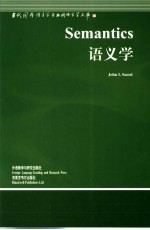图书介绍
语义学PDF|Epub|txt|kindle电子书版本网盘下载

- (英)John I.Saeed著;吴一安导读 著
- 出版社: 北京:外语教学与研究出版社
- ISBN:7560020046
- 出版时间:2000
- 标注页数:365页
- 文件大小:16MB
- 文件页数:415页
- 主题词:语义学 语义学
PDF下载
下载说明
语义学PDF格式电子书版下载
下载的文件为RAR压缩包。需要使用解压软件进行解压得到PDF格式图书。建议使用BT下载工具Free Download Manager进行下载,简称FDM(免费,没有广告,支持多平台)。本站资源全部打包为BT种子。所以需要使用专业的BT下载软件进行下载。如BitComet qBittorrent uTorrent等BT下载工具。迅雷目前由于本站不是热门资源。不推荐使用!后期资源热门了。安装了迅雷也可以迅雷进行下载!
(文件页数 要大于 标注页数,上中下等多册电子书除外)
注意:本站所有压缩包均有解压码: 点击下载压缩包解压工具
图书目录
Part 1 Preliminaries1
1 Semantics in Linguistics3
1.1 Introduction3
1.2 Semantics and Semiotics5
1.3 Three Challenges in Doing Semantics6
1.4 Meeting the Challenges7
1.5 Semantics in a Model of Grammar9
1.5.1 Introduction9
1.5.2 Word meaning and sentence meaning10
1.6 Some Important Assumptions11
1.6.1 Reference and sense12
Preface by Halliday12
1.6.2 Uuerances,sentences and propositions13
王宗炎序13
1.6.3 Literal and non-literal meaning15
导读16
1.6.4 Semantics and pragmatics17
1.7 Summary19
Further Reading19
Exercises20
Notes21
2 Meaning,Thought and Reality23
2.1 Introduction23
2.2 Reference25
2.2.1 Types of reference25
2.2.2 Names27
2.2.3 Nouns and noun phrases28
2.3 Reference as a Theory of Meaning30
2.4 Mental Representations32
2.4.1 Introduction32
2.4.2 Concepts34
2.4.3 Necessary and sufficient conditions35
2.4.4Prototypes37
2.4.5Relations between concepts38
2.4.6Acquiring concepts40
2.5 Words,Concepts and Thinking40
2.5.1 Linguistic relativity41
2.5.2 The language of thought hypothesis43
2.5.3 Thought and reality44
List of Figures and Tables45
2.6 Summary46
Further Reading47
Exercises47
Preface47
Notes49
List of Abbreviations and Symbols49
Part II Semantic Description51
3 Word Meaning53
3.1 Introduction53
3.2 Words and Grammatical Categories55
3.3 Words and Lexical Items55
3.4 Problems and Pinning Down Word Meaning59
3.5 Lexical Relations63
3.5.1 Homonymy63
3.5.2 Polysemy64
3.5.3 Synonymy65
3.5.4 Opposites(Antonymy)66
3.5.5 Hyponymy68
3.5.7 Member-collection70
3.5.6 Meronymy70
3.5.8 Portion-mass71
3.6 Derivational Relations71
3.6.1 Causative verbs71
3.6.2 Agentive nouns72
3.7 Summary73
Further Reading73
Exercises74
Notes76
4 Sentence Relations and Truth79
4.1 Introduction79
4.2 Logic and Truth81
4.3 Necessary Truth,A Priori Truth and Analyticity86
4.4 Entailment90
4.5.1 Introduction93
4.5 Presupposition93
4.5.2 Two approaches to presupposition94
4.5.3 Presupposition failure96
4.5.4 Presupposition triggers97
4.5.5 Presuppositions and context99
4.5.6 Pragmatic theories of presupposition101
Further Reading102
Exercises102
4.6 Summary103
Notes104
5 Sentence Semantics 1:Situations106
5.1 Introduction106
5.2 Classifying Situations107
5.2.1 Introduction107
5.2.2 Verbs and situation types109
5.2.3 A system of situation types113
5.2.4 Tense and aspect114
5.2.5 Comparing aspect across languages120
5.2.6Combining situation type and aspect123
5.3 Modality and Evidentiality125
5.3.1 Modality125
5.3.2 Mood128
5.3.3Evidentiality131
5.4 Summary133
Further Reading133
Exercises134
Notes137
6 Sentence Semantics 2:Participants139
6.1 Introduction:Classifying Participants139
6.2 Thematic Roles140
6.3 Grammatical Relations and Thematic Roles145
6.4 Verbs and Thematic Role Grids147
6.5 Problems with Thematic Roles149
6.6 The Motivation for Identifying Thematic Roles152
6.7 Voice155
6.7.1 Passive voice155
6.7.2 Comparing passive constructions across languages159
6.7.3 Middle voice161
6.8 Summary165
Further Reading165
Exercises166
Notes169
7 Context and Inference172
7.1 Introduction172
7.2.1 Spatial deixis173
7.2 Deixis173
7.2.3 Extensions of spatial deixis177
7.2.2 Grammaticalization of context177
7.2.4 Person deixis178
7.2.5 Social deixis179
7.3 Reference and Context180
7.4 Knowledge as Context181
7.4.1 Discourse as context182
7.4.2 Background knowledge as context183
7.4.3 Mutual knowledge185
7.4.4 Giving background knowledge to computers186
7.5 Information Structure187
7.6 Inference191
7.7 Conversational Implicature192
7.8 Summary196
Exercises197
Further Reading197
Notes202
8 Functions of Language:Speech as Action203
8.1 Introduction203
8.2 Austin s Speech Act Theory206
8.2.1 Introduction206
8.2.2 Evaluating performative utterances208
8.2.3 Explicit and implicit performatives209
8.2.4 Statements as performatives210
8.2.5 Three facets of a speech act211
8.3 Categorizing Speech Acts212
8.4 Indirect Speech Acts214
8.4.1 Introduction214
8.4.2 Understanding indirect speech acts216
8.4.3 Indirect acts and politeness218
8.5 Sentence Types221
8.6 Summary223
Further Reading224
Exercises224
Notes225
Part III Theoretical Approaches229
9 Meaning Components231
9.1 Introduction231
9.2 Lexical Relations in CA232
9.2.1 Binary features233
9.2.2 Redundancy rules233
9.3 Katz s Semantic Theory234
9.3.1 Introduction234
9.3.3 Projection rules235
9.3.2 The Katzian dictionary235
9.4 Grammatical Rules and Semantic Components238
9.4.1 The Methodology238
9.4.2 Thematic roles and linking rules241
9.5 Components and Conflation Patterns245
9.6 Jackendoff s Conceptual Structure249
9.6.1 Introduction249
9.6.2The semantic components250
9.6.3 Localist semantic fields251
9.6.4 Complex events and states253
9.6.5 THINGS:Semantic classes of nominals254
9.6.6 Cross-category generalizations255
9.6.7 Processes of semantic combination256
9.7 Problems with Components of Meaning259
Further Reading261
9.8 Summary261
Exercises262
Notes266
10 Formal Semantics268
10.1 Introduction268
10.2Model-Theoretical Semantics271
10.3 Translating English into a Logical Metalanguage271
10.3.1 Introduction271
10.3.2 Simple statements in predicate logic272
10.3.3 Quantifiers in predicate logic274
10.3.4 Some advantages of predicate logic translation277
10.4 The Semantics of the Logical Metalanguage279
10.4.1 Introduction279
10.4.2 The semantic interpretation of predicate logic symbols279
10.4.3 The domain280
10.4.4 The denotation assignment function281
10.5 Checking the Truth Value of Sentences282
10.5.1 Evaluating a simple statement282
10.5.2 Evaluating a compound sentence with ∧‘and’283
10.5.3 Evaluating sentences with the quantifiers ( and (284
10.6 Intensionality286
10.6.1 Introduction286
10.6.2 Modality287
10.6.3 Tense and aspect289
10.7 Word Meaning:Meaning Postulates291
10.8 Summary293
Further Reading294
Exercises294
Notes297
11.1 Introduction299
11 Cognitive Semantics299
11.2 Metaphor302
11.2.1 Introduction302
11.2.2 Metaphor in cognitive semantics304
11.2.3Features of metaphor305
11.2.4 The influence of metaphor307
11.3 Image Schemas308
11.3.1 Containment schema308
11.3.2 Path schema310
11.3.3 Force schemas311
11.4 Polysemy312
11.4.1 Prepositions312
11.4.2 Modal verbs317
11.5 Mental Spaces319
11.5.1 Connections between spaces320
11.5.2 Referential opacity322
11.5.3 Presupposition326
11.5.4 Section Summary327
11.6 Construing a Scene328
11.6.1 Perspective328
11.6.2 Profiling329
11.6.3 Scanning331
11.7 Summary331
Further Reading332
Exercises332
Notes335
Peferences337
Index354
文库索引361